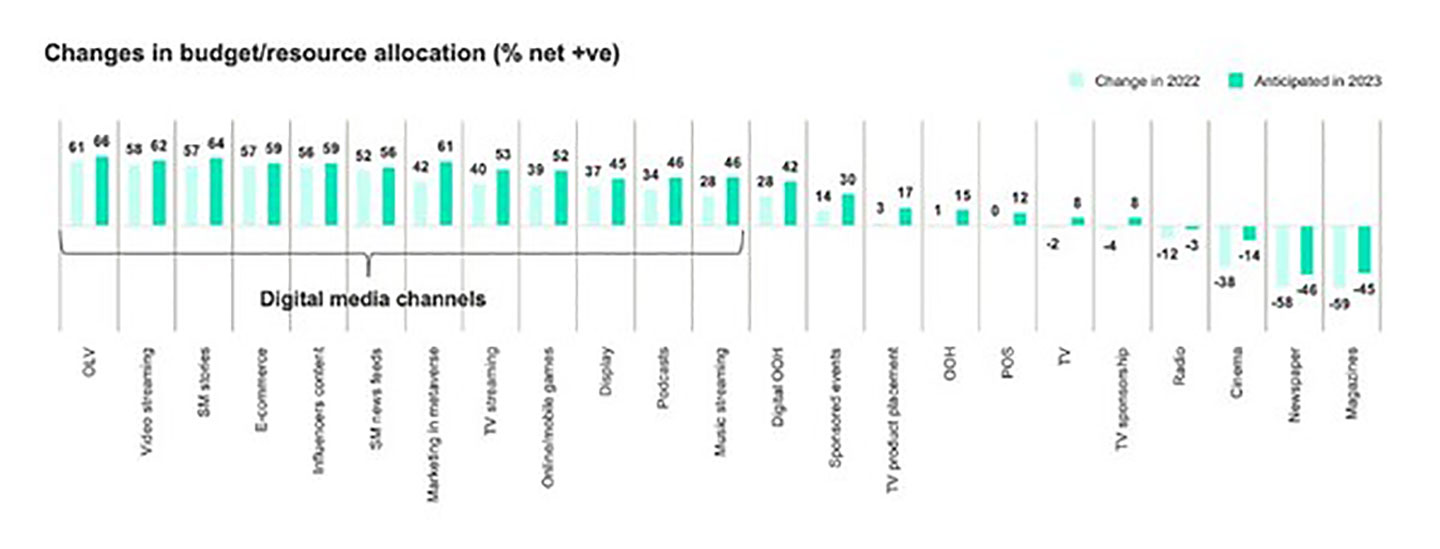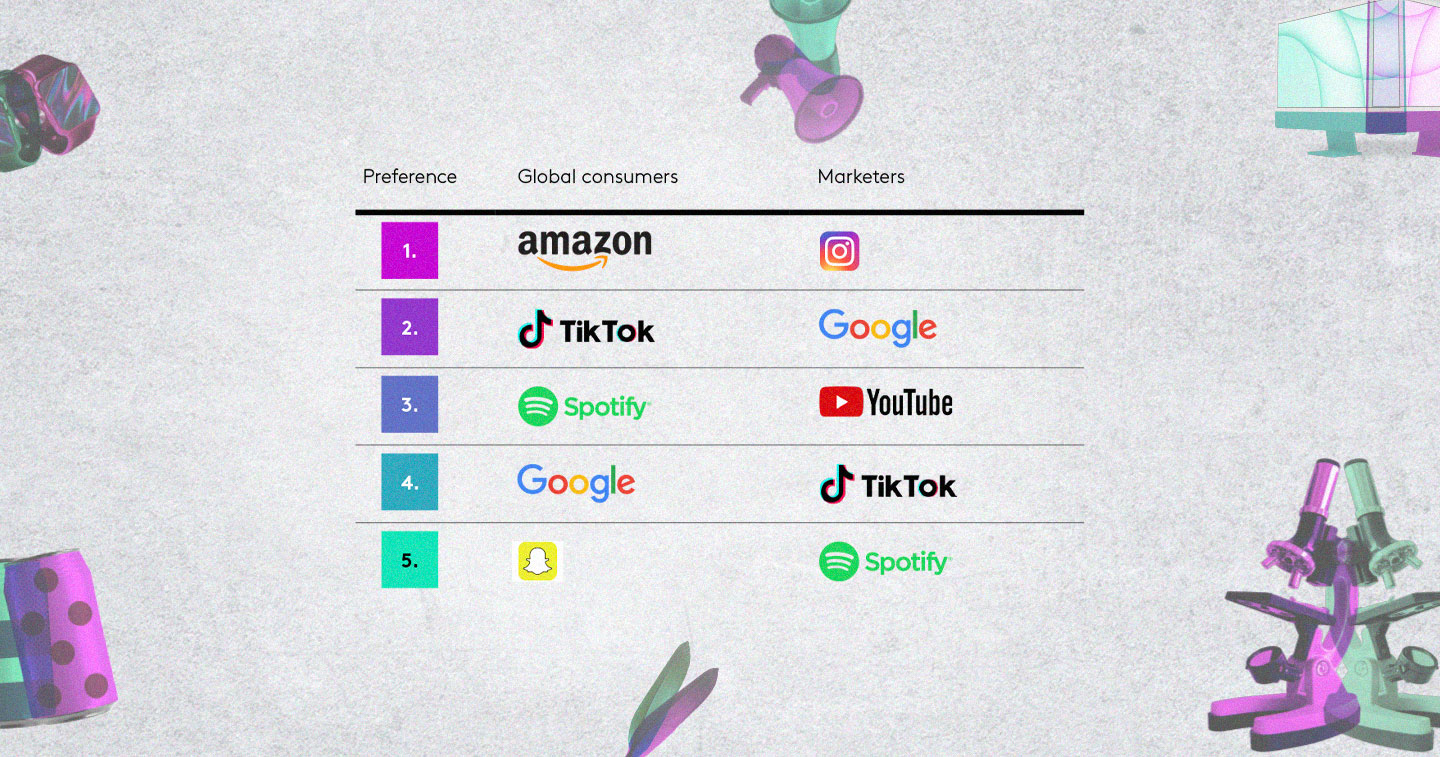LONDON, UK — Data analytics and brand consulting company Kantar has identified ecommerce platform Amazon as the global media brand in which consumers enjoy ads the most. Adverts on the Amazon platform were cited by consumers as more relevant and useful than others. “Media Reactions 2022,” the third edition of Kantar’s global Ad Equity ranking of media channels and media brands, also revealed the following findings:
- For the third consecutive year, “real-world” offline advertising platforms dominate the ranking of formats that consumers favor the most.
- In the digital world, influencer content replaced podcast adverts as the preferred advertising format.
- Despite consumers’ preferences for offline platforms, marketers continue to favor online platforms. More advertisers say they will increase spend on online video in their advertising budget allocations in 2023, as TikTok continues to be regarded as the most innovative media brand.
- A net 61% of advertisers plan to increase their spend in the metaverse in 2023.
Top ranking media channels
Kantar’s Ad Equity metric uniquely identified the places where consumers most appreciate advertising and are least likely to view ads negatively. Across all media channels consumers are most positive about advertising in sponsored events (#1), in magazines (#2) and cinema (#3). Ad equity for almost all online channels increased this year, continuing the trend since 2021.
Within the digital environment, influencer content leads the way as the preferred ad format, with a six point jump in ad equity, followed by ecommerce and podcast ads. Social media story ads and music streaming ads both improved one position in comparison to last year’s results.
| Consumer Global ad equity ranking – all media channels | Consumer Global ad equity ranking – online media channels |
| 1) Sponsored events (+1) | 1) Influencer content (+1) |
| 2) Magazine ads (+1) | 2) Ecommerce ads (+1) |
| 3) Cinema ads (-2) | 3) Podcast ads (-2) |
| 4) Point of sale ads (-) | 4) Social media story ads (+1) |
| 5) Digital out of home ads (+2) | 5) Music streaming ads (+1) |
Global digital media brands
Amazon leads the overall Ad Equity ranking among the nine digital media brands measured globally in 2022. People find ads on Amazon relevant, useful and of better quality, making it the most popular ad platform among consumers this year. Amazon advertising is also the most preferred brand locally in four markets: Germany, Italy, Egypt and Colombia, and in the top five in four other markets.
TikTok, the second most preferred digital brand for Ad Equity, continues to be perceived as innovative and more fun and entertaining than other digital media brands. Spotify jumped four places to reach the third spot, representing the constantly growing music streaming channels and podcasts. Spotify’s strength mainly comes from the perception of quality ads and consumers’ willingness to accept the advertising in the platform. It is placed at the top in Vietnam, and in the top three in Japan and Korea.
Global ad equity media brands: 2022 top rankings among consumers are as follows:

Marketers ranked Instagram, for the second year in a row, as their number one preferred media brand, followed by Google and YouTube, respectively. This year, TikTok has moved three spots in preferences among marketers, to reach the fourth position. 84% of marketers plan to spend more on TikTok in 2023 – more than any other global ad platform.
Top ad equity performers by market
In contrast to last year’s results, consumers’ preferences have divided equally between global and local media platforms. Across 29 surveyed markets, global giants such as Amazon, Google, Twitch, Spotify, Pinterest and Disney were identified in 15 countries as the preferred platforms. 14 of the top advertising performers – from a consumer perspective – around the world are local or localized media brands.
Ad spend outlook
Digital media spend is expected to continue increasing in 2023. Online video, video streaming and social media stories are the top three channels with a net increase in budget allocation in 2022 and 2023, followed by marketing in the metaverse, which marketers say they will increase by 61% in 2023.

Commenting on the findings Jane Ostler, EVP of creative and media solutions at Kantar, added “The media environment continues to evolve rapidly and, in inflationary times, marketers need to make careful choices. Marketers continue to be lured by the siren call of the new and shiny, such as embracing attention as a new metric and the metaverse as a new channel – but it is imperative to maintain a holistic understanding of ad platforms and what consumers think of them.”
TikTok most innovative media brand for a third year
Pablo Gomez, the head of creative & media at Kantar in Singapore and APAC media lead, commented,: “For marketers, it is essential to know which channels and platforms are most effective for your brand, because campaigns are seven times more impactful among a receptive audience. It is important to decide which innovative channels and platform partners to embrace. For the third year, TikTok remains comfortably the most innovative place for ads, which means advertisers can ‘borrow equity’ by choosing these environments.”
He added, “Although TikTok fell from #1 to #2 position in this year’s ad equity ranking among consumers, they have managed to gain higher trustworthiness among marketers – 84% of whom are going to increase their digital media spends in TikTok next year. Last year, marketers were wary of placing trust in TikTok as it was a rising platform – but this year TikTok hit the sweet spot of maintaining its innovation status whilst having earned marketers’ trust. As a result, more marketers are planning to spend more on TikTok than any other global ad platform in 2023.”
“Trust and innovation are the two biggest factors affecting marketers’ perception of media brands. The rising trust in TikTok over the last few years from a novel platform to a social media mainstay has given marketers the confidence to invest. As a result, TikTok has become one of the two brands that appeal the most to both consumers and marketers in 2022, along with Google,” he concluded.
Media Reactions will be explored more during the free webinar on September 07. The full report can be found here.










